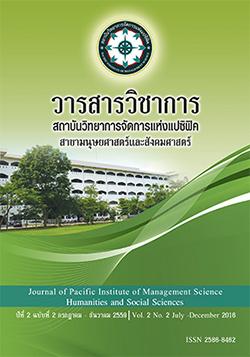The Comparative Quality of Working Life between Permanent Employee and Civil Servant of Military Transportation Department
Keywords:
Comparative Quality of Working Life, Permanent Employees and Civil Servants, Military Transportation DepartmentAbstract
This quantitative research was “The Comparative Quality of Working Life between Permanent Employees and Civil Servants of Military Transportation Department”, the purposes were 1) to study the comparative quality of working life between permanent employees and civil servants of military transportation department and 2) to study factors affecting comparative quality of working life between permanent employees and civil servants of military transportation department. The sample consists of 300 permanent employees and civil servants of military transportation department. This quantitative research interviewed 9 commanders and section chiefs. The data were collected by questionnaires and the interview form and analyzed by percentage, mean, standard deviation and Pearson Correlation with statistically significant difference at .05.
The result of the research revealed that ; the job characteristic was a high level such as the first was the freedom to work, the importance of work, a variety of job skills, the opportunity to recognize their performance. The quality of working life of employees and government employees were at high level such as democratic organization, integrating social, life balance in workplace, progress and stability in the work, development worker, pride in the success of work, adequate compensation and justice, working conditions safe and healthy were respectively. The employees had work-life lower than government employees. The government employees and employees which different in age, family status, education, time to work and number of family members had difference quality of working life at .05 statistic significant.
The job characteristic factors were correlated with the quality of working life at .01 statistic significant. The variable of a variety of skills, the identity of work, the importance of work, the freedom to work and opportunity to recognize their performance to describe the quality of working life of employees was 68.40 percentage.
References
จุฑารัตน์ สุคันธรัตน์ . (2541). การรับรู้บรรยากาศองค์กรและความเครียดของบุคลากรในโรงพยาบาลตากสิน. รายงานการวิจัย สาขาจิตวิทยาอุตสาหกรรมและองค์การ คณะศิลปศาสตร์ , มหาวิทยาลัยธรรมศาสตร์ .
ชาญชัย อาจินสมาจาร. (2547). การบริหารทรัพยากรมนุษย์ . กรุงเทพฯ : สำนักพิมพ์ มหาวิทยาลัยธรรมศาสตร์ .
สมาน รังสิโยกฤษฎ์ . (2542). ความรู้ทั่วไปเกี่ยวกับการบริหารงานบุคคล. พิมพ์ครั้งที่ 18. กรุงเทพฯ : สวัสดิการสำนักงาน ก.พ.
Bernard, S. E. (2003). Defining and measuring the quality of working life. In L. E. Davis & A. B. Cherns (Eds.). The quality of work life (pp. 105 - 118). New York: The Free Press.
Brook & Anderson. (2005). Quality of Work Life. In R. L. Shalock (Ed.), Quality of life: Perspectives and Issues (pp. 27-40). Washington, DC: American Association on Mental Retardation.
Dessler. (1997). Who Govern? democracy and power in an American city. New Haven: Yale University.
Hackman, J. R., & Oldham G.R. (1980). Work redesign Canada Addison Wesley. New York: Mc Graw-Hill.
Huse, Edgar F. and Tomas G. Cumming. (2005). Organization Development and Change. 3th ed. Minnerota : West Publishing. Mondy, R. W., & Noe, R. M. (1996). Human Resource Management. Englewood Cliffs, NJ: Prentice-Hall.
Newstron and Davis. (1997). Quality of Life, Health and Happiness. Alders hot, England: Avebury.
Walton, R. E. (1994). Improving the quality of work life. Harvard Business Review, 52(3), 12.
Downloads
Published
Issue
Section
License
บทความที่ได้รับการตีพิมพ์เป็นลิขสิทธิ์ของ สถาบันวิทยาการจัดการแห่งแปซิฟิค
ข้อความที่ปรากฏในบทความแต่ละเรื่องในวารสารวิชาการเล่มนี้เป็นความคิดเห็นส่วนตัวของผู้เขียนแต่ละท่านไม่เกี่ยวข้องกับสถาบันวิทยาการจัดการแห่งแปซิฟิค และคณาจารย์ท่านอื่นๆในสถาบันฯ แต่อย่างใด ความรับผิดชอบองค์ประกอบทั้งหมดของบทความแต่ละเรื่องเป็นของผู้เขียนแต่ละท่าน หากมีความผิดพลาดใดๆ ผู้เขียนแต่ละท่านจะรับผิดชอบบทความของตนเองแต่ผู้เดียว







